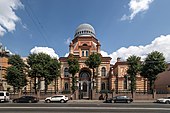Moorish Revival architecture
Moorish Revival or Neo-Moorish is one of the exotic revival architectural styles that were adopted by architects of Europe and the Americas in the wake of Romanticist Orientalism. It reached the height of its popularity after the mid-19th century, part of a widening vocabulary of articulated decorative ornament drawn from historical sources beyond familiar classical and Gothic modes. Neo-Moorish architecture drew on elements from classic Moorish architecture and, as a result, from the wider Islamic architecture.[1]
Munich synagogue, by , 1832 was the earliest Moorish revival synagogue (destroyed on Kristallnacht)
Friedrich von Gärtner
Budapest, Hungary, 1854–1859
Dohány Street Synagogue
Cracow, Poland, 1860–62
Tempel Synagogue
Timişoara, Romania, by Ignaz Schumann, 1864–65
Cetate Synagogue
1867
Zagreb Synagogue
France, 1867–1870
Synagogue of Besançon
Budapest, Hungary, 1872
Rumbach Street synagogue
Tempio Maggiore, Florence, Italy, 1874–82
Great Synagogue of Florence
Italy, 1884
Turin synagogue
Hungary, 1888
Esztergom Synagogue
synagogue, France, 1891
La Ferté-sous-Jouarre
Ukraine, 1895
Great Choral Synagogue (Kyiv)
synagogue, Czech Republic, 1895
Opava
Prešov synagogue, , Slovakia, 1898
Prešov
synagogue, Slovakia, 1886, rebuilt 1900
Malacky
1902
Sarajevo Synagogue
Prague, Czech Republic, 1906
Jubilee Synagogue
Groningen, Netherlands, 1906
Groningen Synagogue
Minsk, Belarus, 1906
Choral Synagogue
Belgrade, Serbia, 1908.
Bet Israel Synagogue
Sofia, Bulgaria, 1909
Sofia Synagogue
Kyiv, Ukraine, 1909
Galitska Synagogue
Moldova, 1913
Chișinău Choral Synagogue
Arabian House (Hotel Jadran) , North Macedonia, 1936–38
Skopje
Gibraltar (1825–1832) an early example of Moorish revival architecture is located in Gibraltar, which formed part of Moorish Al-Andalus between 711 and 1462 AD.
The Cathedral of the Holy Trinity
(a.k.a. Jesuit Church) is a striking example of Moorish Revival Architecture. Across the street was the College of the Immaculate Conception, housing a chapel with two stained glass domes. The chapel was disassembled and about half of it (one of the stained glass domes, eleven of the windows) was installed in the present Jesuit High School.
Immaculate Conception Church (New Orleans)
Richmond, Virginia, currently Altria Theater, formerly 'The Landmark Theater' and 'The Mosque'
Acca Temple Shrine
Helena, Montana
Algeria Shrine Temple
Washington D.C.
Almas Temple
Phoenix, Arizona
El Zaribah Shrine Auditorium
Jerusalem Temple, New Orleans, Louisiana, built at 1137 St. Charles Avenue in 1918 by architect Emile Weil.
Indianapolis, Indiana, the largest Shrine temple in North America, now officially known as Old National Centre.
Murat Shrine
now used as a concert hall
New York City Center
Los Angeles, California
Shrine Auditorium
Milwaukee, Wisconsin
Tripoli Shrine Temple
The , while not a Shrine Temple, is a Masonic building that uses the Moorish Revival architectural style.
Scottish Rite Temple in Santa Fe, New Mexico
Karem Shrine Temple, Waco, Texas; now Hotel 1928
The Shriners, a fraternal organization, often chose a Moorish Revival style for their Temples. Architecturally notable Shriners Temples include:
Palace of Manguinhos, site of the , in Rio de Janeiro, Brazil, 1905-1918
Oswaldo Cruz Foundation
"Mosque" shaped steam-generation plant in , Potsdam, Prussia, 1842
Sanssouci Park
The , Vienna, 1892
Zacherlfabrik
City hall, , Bosnia and Herzegovina, 1892
Brcko
City hall, , Bosnia and Herzegovina, 1894
Sarajevo
Jewish Hospital, , Ukraine, 1900
Lviv
Mostar, Bosnia and Herzegovina, 1902
Mostar Gymnasium
Former , Dresden, Germany, 1908 (here, the "minarets" are used to disguise smokestacks)
Yenidze Cigarette Factory
Bandung, Indonesia, 1924
Gedung Sate
Saint-Martin-le-Vinoux, France, 1855
Casamaures
St. Augustine, FL, 1883
Villa Zorayda
Lisbon, 1892
Campo Pequeno bullring
Tampa, FL, 1891
Henry B. Plant Museum
Karlo Helmbold's House (Šeherezada), Zrenjanin, Serbia, by Ištvan Bart, 1900
Atwater water treatment plant, , Montreal, QC, 1912–18
Canal de l'Aqueduc
Hall (Yale senior society building, New Haven, CT; 1869 and 1901)
Scroll and Key
Scroll and Key Hall; New Haven, Connecticut (Yale senior society building). This is a proposed plan of ca. 1867. Only far left structure was built.
Moorish Revival architecture in Bosnia and Herzegovina
Islamic architecture
Indo-Saracenic Revival architecture
Naylor, David (1987). Great American Movie Theaters. Washington, D.C.: The Preservation Press. 9780891331278.
ISBN
Thorne, Ross (1976). Picture Palace Architecture in Australia. South Melbourne, Australia: Sun Books Pty. Ltd. 072510225X.

























